Search results for: 'form'
-
 Minoische Votivfigur in Form eines Hundes
Minoische Votivfigur in Form eines HundesStehender Hund, der Kopf nach vorne gereckt, nach oben stehende Ohren. Orangefarbener Ton mit Resten eines roten Überzugs. Sehr gute Erhaltung.
Price: on request Old Babylonian cuneiform tablet
Old Babylonian cuneiform tabletVery nicely preserved clay tablet with cuneiform legal text from Old Babylonian times.
Price: on request Old Babylonian cuneiform tablet
Old Babylonian cuneiform tabletVery nicely preserved clay tablet with cuneiform administrative text from Old Babylonian times.
Price: on request Old Babylonian cuneiform tablet
Old Babylonian cuneiform tabletInteresting small clay tablet with cuneiform legal text from Old Babylonian times.
€1,890 Old Babylonian cuneiform tablet
Old Babylonian cuneiform tabletLarge clay tablet with cuneiform administrative text from Ur III to Old Babylonian times.
Price: on request Old Babylonian cuneiform tablet
Old Babylonian cuneiform tabletClay tablet with cuneiform administrative or legal text. Dating to the reign of Ammi-Ditana, a king of the first dynasty of Babylon.
€2,430 Old Babylonian cylinder seal with cuneiform inscription
Old Babylonian cylinder seal with cuneiform inscriptionWorship scene for a god. Mention of moon god Sîn and Aya, wife to the sun god, in the inscription. 1900 to 1600 BC.
Price: on request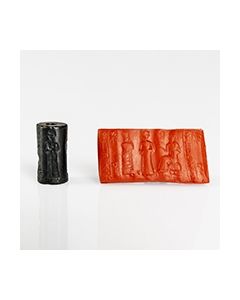 Old Babylonian cylinder seal with cuneiform inscription
Old Babylonian cylinder seal with cuneiform inscriptionWorship scene for a god. Mention of the Babylonian gods of storm, moon and sun in the inscription.
Price: on request Mummyform Near Eastern idol
Mummyform Near Eastern idolThe unusual bronze figurine is an idol from Anatolia or the Near East. Around 1000 BC.
Price: on request Clay tablet with cuneiform text
Clay tablet with cuneiform textSmall cuneiform writing tablet with well preserved text on both sides.
Price: on request Mesopotamian cuneiform tablet
Mesopotamian cuneiform tabletSmall clay tablet with well preserved Sumerian cuneiform writing. From Mesopotamia, probably from Uruk.
Price: on request Cuneiform tablet from Umma
Cuneiform tablet from UmmaRecord of beer and bread rations for laborers. Probably from the Bronze Age city of Umma. The cuneiform tablet was studied and conserved at Yale University.
Price: on request Clay tablet with cuneiform script
Clay tablet with cuneiform scriptSmall tablet with well preserved cuneiform engravings. Interesting Bronze Age document from Mesopotamia.
Price: on request Sumerian cuneiform clay tablet
Sumerian cuneiform clay tabletSmall tablet with drill hole. Cuneiform receipt for bricks or pottery. Very well preserved piece from the late 3rd millenium BC.
Price: on request Core-formed polychrome glass alabastron
Core-formed polychrome glass alabastronNice and small vessel with a strong patina. It is not a classical type of alabastron and retains a few mysteries.
€755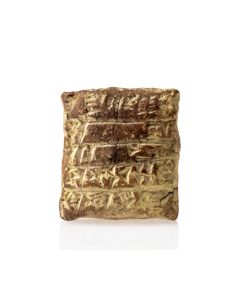 Sumerian cuneiform tablet
Sumerian cuneiform tabletThe clay tablet is a receipt of sheep and goats from the Sumerian city of Puzrish-Dagan. It was made during the reign of King Shu-Sin, 2037 to 2029 BC. From the Yale University Collection.
Price: on request Clay tablet with cuneiform text
Clay tablet with cuneiform textSmall cuneiform writing tablet with well preserved text on both sides.
Price: on request Griechischer oder Kuschana-Armreif aus Bronze
Griechischer oder Kuschana-Armreif aus BronzeAußenseite mit paarweise angeordneten Noppen in Form abgeflachter Halbkugeln dekoriert. Museale Erhaltung.
Price: on request Einhenkliger Keramikkrug aus dem Nahen Osten
Einhenkliger Keramikkrug aus dem Nahen OstenDer Körper in Form eines Granatapfels, unten zu einem Standfuß abgeflacht. Hellorangefarbene Keramik. Fund von der Levante.
Price: on request Öllampe der Indus-Kultur - selten
Öllampe der Indus-Kultur - seltenFlache tropfenförmige Öllampe mit breiter Standfläche. Auf einer Drehscheibe gefertigt, dann von Hand in endgültige Form gebracht.
Price: on request Dreieckfibel aus dem östlichen Mittelmeerraum
Dreieckfibel aus dem östlichen MittelmeerraumBügel in Form eines gespannten Rundbogens. Verzierung aus zahlreichen Querrillen auf dem Bügel. Nadel über eine doppelte Windung gefedert. 8. bis 6. Jh. v. Chr.
Price: on request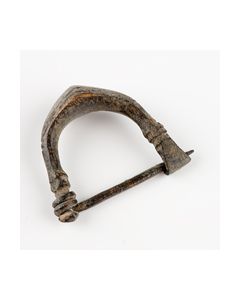 Levantinische Bronzefibel
Levantinische BronzefibelEisenzeitliche Fibel, etwa 8. - 5. Jh. v. Chr. Vollständig intakt, Nadel noch voll beweglich. An Kopf Halterung in Form einer Hand. Aus alter deutscher Privatsammlung.
Price: on request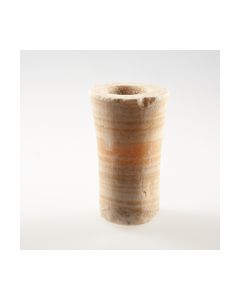 Baktrisches Alabastergefäß für kultische Zwecke
Baktrisches Alabastergefäß für kultische ZweckeSäulenartige Form, öffnet sich leicht zur Oberseite hin. In diese ist eine Mulde eingelassen. Das Gefäß ähnelt in seiner Form den baktrischen Säulenidolen.
Price: on request Henkelkrug aus der Mittleren Bronzezeit
Henkelkrug aus der Mittleren BronzezeitTypische Keramik für den Nahen Osten, die Form weist Parallelen zur sogennanten Tell el-Yahudiyeh Keramik auf. Etwa 2000 v. Chr. bis 1550 v. Chr. Exzellent erhalten.
Price: on request Horse bit from Luristan
Horse bit from LuristanDelightful artefact attesting the dawn of horse breeding in Western Iran during the 8th century BC. Highly stylized horses form the cheek pieces.
€2,840 Bronze pin from Iron Age Luristan
Bronze pin from Iron Age LuristanThree decorative spheres form an elegant pin head. Colourful bronze patina.
Price: on request Canaanite oil lamp
Canaanite oil lampShallow bowl with high rim pinched to form single wick-rest, convex underside. From the collection of Prof. Ritschel, Salzburg, decorated many times, for example in 1995 when the Republic of Austria awarded its Decoration for Science and Art.
Price: on request Dunkelrote Öllampe der Indus-Kultur - selten
Dunkelrote Öllampe der Indus-Kultur - seltenFlache tropfenförmige Öllampe mit breiter Standfläche. Auf einer Drehscheibe gefertigt, dann von Hand in endgültige Form gebracht.
Price: on request Horse bit from Luristan
Horse bit from LuristanDelightful artefact attesting the dawn of horse breeding in Western Iran during the 8th century BC. Figural decorations form the cheek pieces.
€1,800 Luristan hatchet with eyes
Luristan hatchet with eyesAxe head originating from the Luristan region during Iron Age. The piece is decorated with eyes to form a stylized bird's head.
€730 Horse bit from Luristan
Horse bit from LuristanDelightful artefact attesting the dawn of horse breeding in Western Iran during the 8th century BC. Two joined triangles form the cheek pieces.
€1,420 Luristan battle axe with eyes
Luristan battle axe with eyesAxe head originating from the Luristan region during Early Bronze Age. The piece is decorated with eyes to form a stylized bird's head.
€740 Imposing elamite ceramic spouted jar
Imposing elamite ceramic spouted jarThe jar has a biconical body and a spout in form of a stilized bird's head. From ancient Iran at the beginning of the 1st Millenium BC.
Price: on request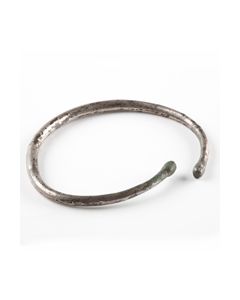 Massiver vorantiker Silberarmreif
Massiver vorantiker SilberarmreifSchwerer Armreif oder Fußreif aus Silber, Durchmesser ca. 112mm, Gewicht 105,7 Gramm. 2. bis 1. Jt. v. Chr., möglicherweise Lorestanisch.
Price: on request Skarabäusamulett mit Löwendarstellung
Skarabäusamulett mit LöwendarstellungAuf der Unterseite laufender Löwe im Stil der Werkstätten von Naukratis. Etwa 8. bis 6. Jh. v. Chr.
Price: on request Großer Henkelkrug mit spitzem Fuß
Großer Henkelkrug mit spitzem FußEinhenkler. 200mm hoch. Mittlere Bronzezeit II, 2000 v. Chr. bis 1550 v. Chr. Ungewöhnliche Formvariante für diese Zeit. Aus Palästina.
Price: on request

